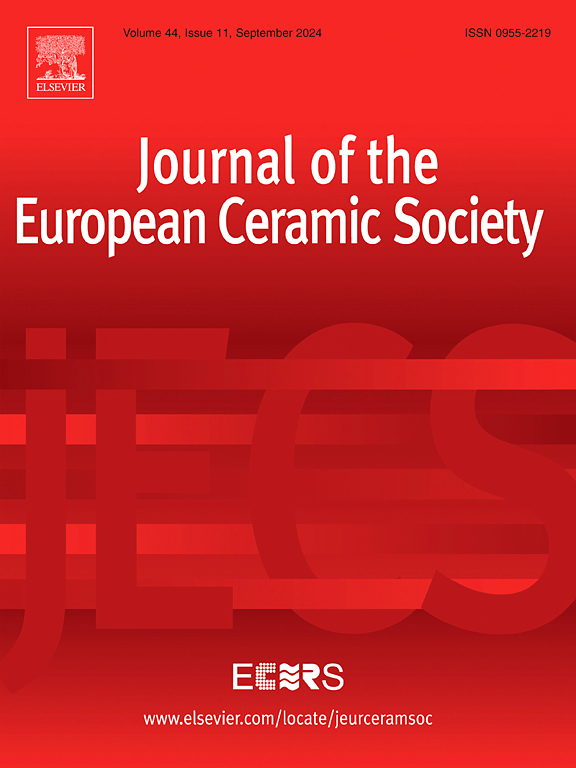Ferroelastic domain switching and toughening mechanism for T’-YSZ@Al2O3 core-shell structured ceramic materials
IF 6.2
2区 材料科学
Q1 MATERIALS SCIENCE, CERAMICS
Journal of The European Ceramic Society
Pub Date : 2025-05-26
DOI:10.1016/j.jeurceramsoc.2025.117561
引用次数: 0
Abstract
The metastable tetragonal (T’) phase yttria-stabilized zirconia (T’-YSZ) exhibits exceptional fracture toughness, offering potential for improving the insufficient toughness of high-temperature HfO₂-based thermal barrier coatings. In our prior work, a T’-YSZ@Al2O3 core-shell structure was developed to suppress ion diffusion between the T’-YSZ reinforcing phase and cubic yttria-stabilized hafnia (C-YSH) matrix, thereby stabilizing the phase structure and enhancing fracture toughness through ferroelastic toughening. Building on this foundation, we systematically investigated the influence of Al2O3 shell thickness on ferroelastic domain switching by fabricating T’-YSZ@Al2O3 ceramics with varying shell-to-core volume ratios (10 %, 20 %, 30 % Al2O3, denoted as CS10 %, CS20 %, CS30 %) via spark plasma sintering (SPS). Multiscale characterization (SEM, XRD, TEM, Raman) combined with FIB-assisted localized analysis and mechanical testing revealed that within a shell-core volume ratio range of 0–30 %, both hardness and elastic modulus increased monotonically with shell thickness. Notably, the fracture toughness peaked at 6.59 MPa·m1/2 for CS20 % (shell-to-core ratio 0.2), representing an 18.5 % improvement over pure T’-YSZ. Beyond this threshold, excessive Al2O3 compromised toughness by reducing the T’-YSZ reinforcement content. Furthermore, the Al2O3 shell induced tensile stress within the T’-YSZ core, facilitating stress-driven ferroelastic domain switching. This interfacial stress engineering effectively enhanced domain switching and improving ferroelastic toughening efficiency.
T′-YSZ@Al2O3核壳结构陶瓷材料的铁弹性畴切换和增韧机理
亚稳四方(T′)相钇稳定氧化锆(T′-YSZ)具有优异的断裂韧性,为改善高温HfO₂基热障涂层的韧性不足提供了潜力。在我们之前的工作中,我们开发了一种T ' -YSZ@Al2O3核壳结构来抑制T ' -YSZ增强相和立方钇稳定铪(C-YSH)基体之间的离子扩散,从而稳定相结构并通过铁弹性增韧提高断裂韧性。在此基础上,我们系统地研究了Al2O3壳层厚度对铁弹性畴切换的影响,通过火花等离子烧结(SPS)制备了不同壳芯体积比(10 %,20 %,30 % Al2O3,分别表示为CS10 %,CS20 %,CS30 %)的T ' -YSZ@Al2O3陶瓷。多尺度表征(SEM, XRD, TEM, Raman)结合fib辅助局部分析和力学测试表明,在壳芯体积比0-30 %范围内,硬度和弹性模量随壳厚单调增加。值得注意的是,CS20 %(壳芯比0.2)的断裂韧性峰值为6.59 MPa·m1/2,比纯T ' -YSZ提高了18.5 %。超过这个阈值,过量的Al2O3通过降低T ' -YSZ增强含量而降低韧性。此外,Al2O3壳层在T ' -YSZ核内诱导拉伸应力,促进应力驱动的铁弹性畴切换。这种界面应力工程有效地增强了畴切换,提高了铁弹性增韧效率。
本文章由计算机程序翻译,如有差异,请以英文原文为准。
求助全文
约1分钟内获得全文
求助全文
来源期刊

Journal of The European Ceramic Society
工程技术-材料科学:硅酸盐
CiteScore
10.70
自引率
12.30%
发文量
863
审稿时长
35 days
期刊介绍:
The Journal of the European Ceramic Society publishes the results of original research and reviews relating to ceramic materials. Papers of either an experimental or theoretical character will be welcomed on a fully international basis. The emphasis is on novel generic science concerning the relationships between processing, microstructure and properties of polycrystalline ceramics consolidated at high temperature. Papers may relate to any of the conventional categories of ceramic: structural, functional, traditional or composite. The central objective is to sustain a high standard of research quality by means of appropriate reviewing procedures.
 求助内容:
求助内容: 应助结果提醒方式:
应助结果提醒方式:


